#伊弉冉尊
Explore tagged Tumblr posts
Text
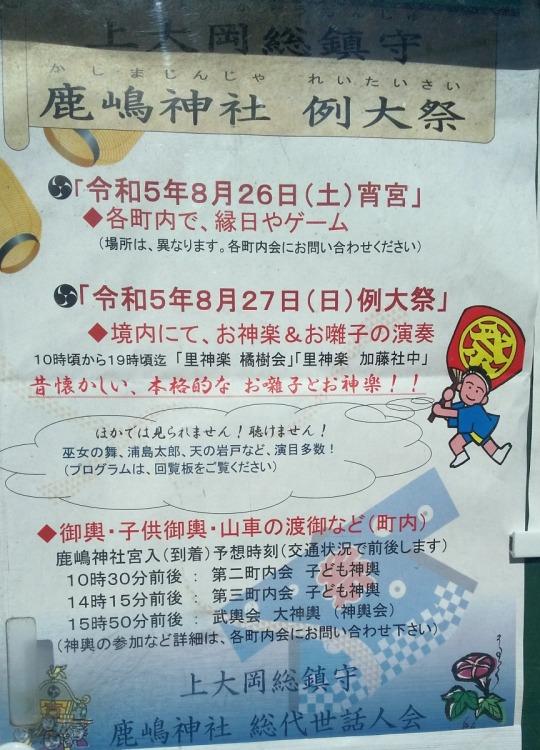
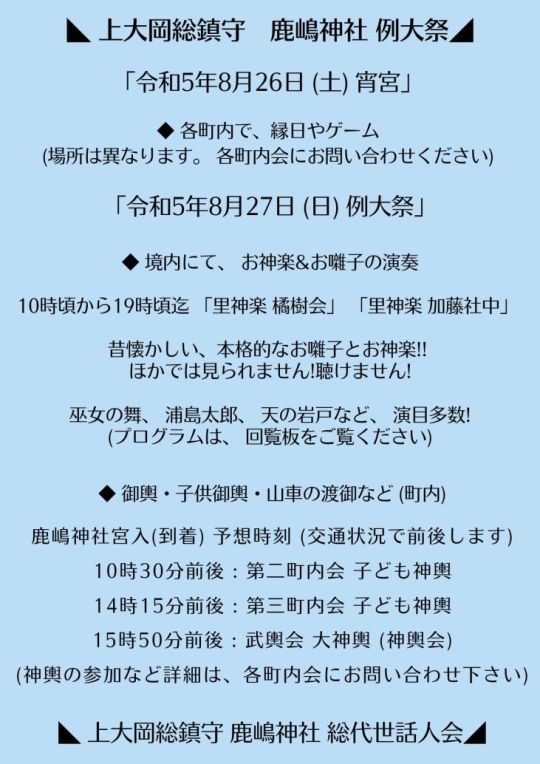
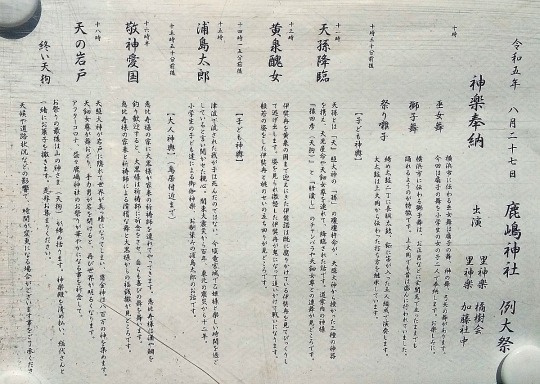

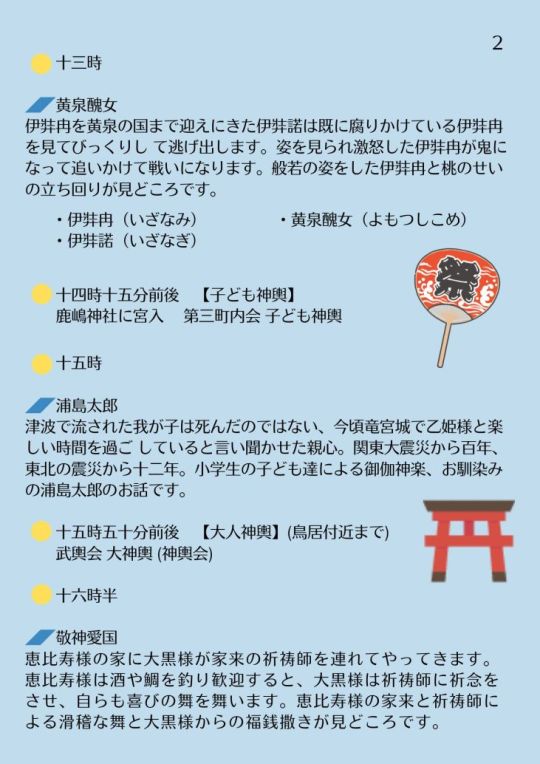

上大岡総鎮守 鹿嶋神社 例大祭
■令和5年8月26日 (土) 宵宮
◆各町内で、縁日やゲーム
(場所は異なります。 各町内会にお問い合わせください)
■令和5年8月27日 (日) 例大祭
◆境内にて、 お神楽&お囃子の演奏
10時頃から19時頃迄「里神楽 橘樹会」「里神楽 加藤社中」
昔懐かしい、本格的なお囃子とお神楽!!
ほかでは見られません!聴けません!
巫女の舞、浦島太郎、天の岩戸など、演目多数!
(プログラムは、 回覧板をご覧ください)
◆御輿・子供御輿・山車の渡御など (町内)
鹿嶋神社宮入(到着) 予想時刻 (交通状況で前後します)
●10時30分前後 : 第二町内会 子ども神輿
●14時15分前後 : 第三町内会 子ども神輿
●15時50分前後 : 武輿会 大神輿 (神輿会)
(神輿の参加など詳細は、各町内会にお問い合わせ下さい)
■上大岡総鎮守 鹿嶋神社 総代世話人会
—————————— ———————
町内掲示板より 2023-07-31
════════ ═ ═══════
■近隣の ⛩️天照大神 令和5年例大祭
9/2(土)-9/3(日) のお知らせ テキスト化
《 ⛩️ 天照大神 境内の掲示物より 》
════════ ═ ═══════
鹿嶋神社 例大祭 スケジュール - テキスト化
令和五年八月二十七日(日)
神楽奉納 出演/「里神楽 橘樹会」「里神楽 加藤社中」

■十時
●巫女舞 横浜市に伝わる巫女舞は扇子の舞、榊の舞、弓矢の舞があります。 今回は扇子の舞を小学生の女の子二人で奉納します。お楽しみに。 ●獅子舞 横浜市に伝わる獅子舞は、お正月などに玄関先で立ったままでも踊れるようのが特徴です。 上大岡でも昔は盛んに行われていました。 ●祭り囃子 締め太鼓二丁に長胴太鼓、鉦に笛が入った五人編成で演奏します。大太鼓は上大岡から伝わった打ち方を継承しています。
■十時三十分前後 【子ども神輿】
●鹿嶋神社に宮入 第二町内会子ども神輿
■十一時
●天降降臨 天孫とは「天」天照大神の「孫」の瓊瓊杵尊が、天照大神から授かった三種の神器を携え、天児屋命や天鈿女尊を連れて、降臨された話です。道案内の神様 「猿田彦(天狗)」と「肝潰し」のチャンバラや天鈿女尊との連舞が見どころです。
◆天照大神(あまてらす おおみかみ) ◆瓊瓊杵尊(ににぎのみこと) ◆天児屋命(あめのこやねのみこと) ◆天鈿女尊 (あめのうずめのみこと) ◆猿田彦 (さるたひこ)
■十三時
●黄泉醜女 伊弉冉を黄泉の国まで迎えにきた伊弉諾は既に腐りかけている伊弉冉を見てびっくりして逃げ出します。姿を見られ激怒した伊弉冉が鬼になって追いかけて戦いになります。般若の姿をした伊弉冉と桃のせいの立ち回りが見どころです。
◆伊弉冉 (いざなみ) ◆伊弉諾 (いざなぎ) ◆黄泉醜女 (よもつしこめ)
■十四時十五分前後 【子ども神輿】
●鹿嶋神社に宮入 第三町内会 子ども神輿
■十五時
●浦島太郎 津波で流された我が子は死んだのではない、今頃竜宮城で乙姫様と楽しい時間を過ごしていると言い聞かせた親心。関東大震災から百年、東北の震災から十二年。小学生の子ども達による御伽神楽、お馴染みの浦島太郎のお話です。
■十五時五十分前後 【大人神輿】
●武輿会 大神輿 (神輿会) 鳥居付近まで
■十六時半
●敬神愛国 恵比寿様の家に大黒様が家来の祈祷師を連れてやってきます。恵比寿様は酒や鯛を釣り歓迎すると、大黒様は祈祷師に祈念をさせ、自らも喜びの舞を舞います。恵比寿様の家来と祈祷師による滑稽な舞と大黒様からの福銭撒きが見どころです。
■十八時
●天の岩戸 天照大神が岩戸に隠れて世界が真っ暗になってしまい、思金神は八百万の神を集めます。天鈿女尊が舞おどり、手力男が岩を開けると、再び世界が明るくなります。アフターコロナ、益々 鹿嶋神社のお祭りが華やかになる事を祈念して。 ◆手力男 (たじからお)
●終い天狗 お祭りの最後は山の神さま(天狗)が締め括ります。神楽殿を清め払い、 総代さんと一緒にお菓子を撒きます。是非お集まりください。
■天候や道路状況などの影響で、時間が変更になる場合がございます事をご了承ください
════════ ══ ═══════
2 notes
·
View notes
Photo
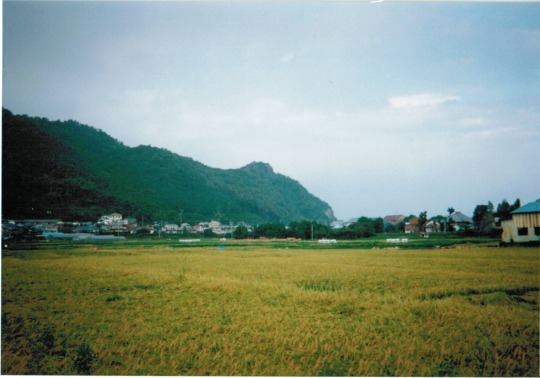
Gazing across rice fields towards the mountains along the far end on the right of which is the sacred rock cliff of Hana no Iwaya Jinja Shrine (花窟神社) in Kumano City, Mie Prefecture, referenced in the “Chronicles of Japan” (日本書紀) (compiled in 720) as the burial tomb of the progenitor goddess Izanami no Mikoto (伊邪那美命) after her demise giving birth to the fire deity
(Photo taken September 1, 1996)
9 notes
·
View notes
Text
白良浜/和歌山県白浜町【ウォーキング】関西随一の人気を誇る雪のように白い砂浜を歩く
白良浜とは 白良浜(しららはま)は、和歌山県西牟婁郡白浜町(わかやまけんにしむろぐんしらはまちょう)にある砂浜だ。 延長620mの遠浅の浜で、90%の珪酸を含む石英砂からなる白い浜辺で知られる。 白浜の名の由来にもなった延長約620mに渡る白砂の浜。毎年約60万人が訪れる関西屈指のこの美しいビーチは「日本の快水浴場百選」にも選ばれています。白い砂、エメラルドグリーンの海、椰子の木の並ぶ風景など、姉妹浜のワイキキビーチを連想させるほどリゾート気分が味わえます。 白良浜|スポット|南紀白浜観光協会 から引用 (more…)

View On WordPress
#オーストラリア#どんど焼き#ブラタモリ#ライトアップ#事解男命#伊弉冉尊#八坂神社#和歌山県#地主神社#寂念法師#恵比須神社#海水浴場#熊野三所神社#白浜町#白濱薬師堂#白良浜#石英#砂浜#西牟婁郡#西行#速玉男命#門松#駐車場
0 notes
Text
淡路島で伊弉諾神宮を参拝
淡路島の北エリアを周遊するバスに乗り1時間弱くらい。海側の景色や町の中を通り、島の景色を眺めながら、ようやく到着。



どんよりとしたお天気になってきて、天候があやしかったけれど雨にはならず。
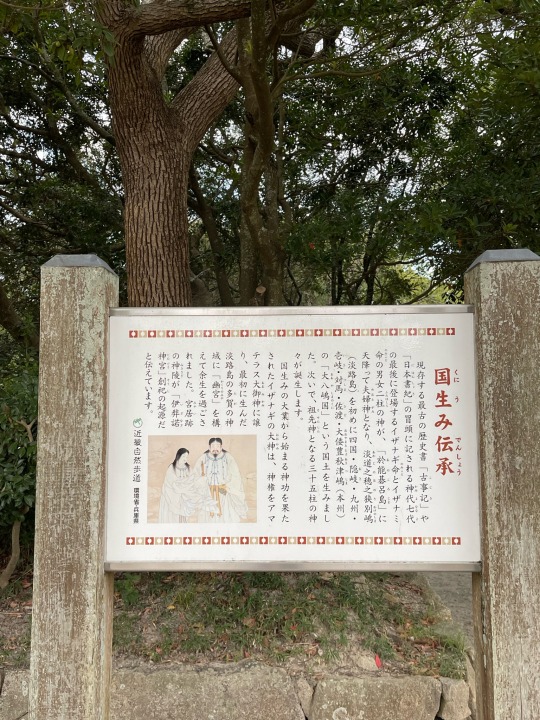
祀られているのは、神話に登場する国生みの神さま伊弉諾尊(いざなぎのみこと)と伊弉冉尊(いざなみのみこと)。
天照大御神をはじめとする八百万の神々を生んだ神。古事記にも記載があるのは、受験の時の日本史でうっすらと記憶しているけれど、日本って今さらだけども、神話の国なんだな〜、と。
さほど詳しくない私も、こ��してご縁をいただくと、日本の神話をもっと知りたくなる。
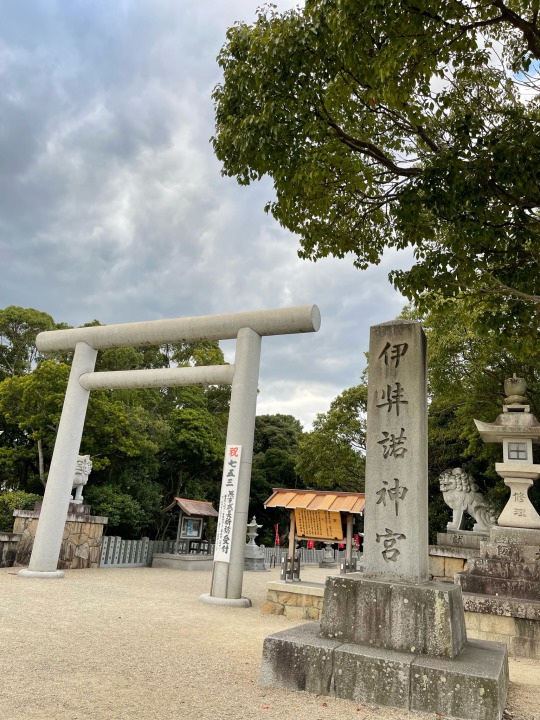

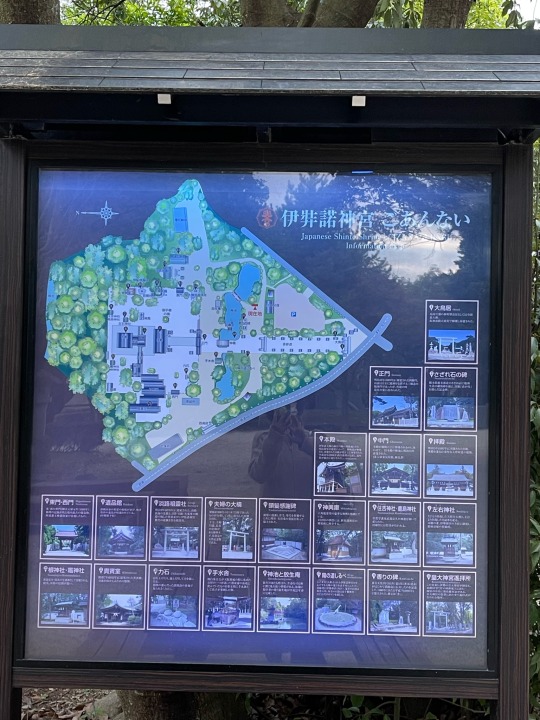
参拝のため拝殿に向かうと、立て掛けられていた旗のスローガンにびっくり&ドン引きして、一通りお参りしそそくさと後にした。
何が書かれていたかというと、憲法改正の実現を…というメッセージで目を疑ったんだよね。憲法9条のことだと思うけれど、改正に反対している身としては、お賽銭すら返してほしいと思ってしまった。
そんなこともあり、なんの名残り惜しい気持ちもなく、またバスに乗って、宿へ戻る。
0 notes
Photo
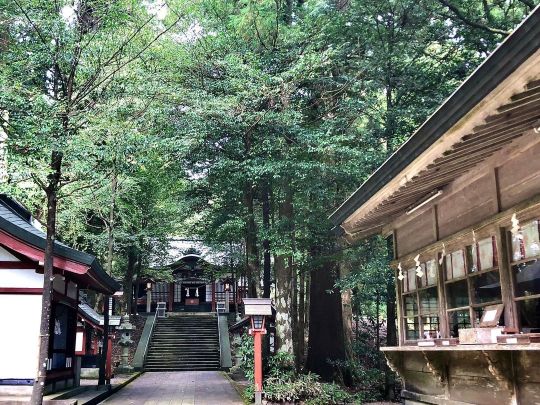
#鹿児島県 と #宮崎県 にまたがる #高千穂峰 は #霊峰 の中の霊峰。 #ニニギノミコト ( #瓊瓊杵尊 )が #降臨 した( #天孫降臨 )とされる、いわば #日本 の始まりの山。 その高千穂峰の頂きに刺さる #天逆鉾 を #御神体 とするのが #霧島東神社 で、主祭神は #伊弉諾尊 (いざなぎのみこと)と #伊弉冉尊 (いざなみのみこと)。 近年、特に #パワースポット として有名です。 観光客もまばらなこの日、大いに #霊気 を浴びながらのお参りとなりました。 #霧島 #神社 #杜 #霊験 #spiritualplace #historyofjapan #mythology #japan (霧島東神社) https://www.instagram.com/p/CU12aUWL2Ks/?utm_medium=tumblr
#鹿児島県#宮崎県#高千穂峰#霊峰#ニニギノミコト#瓊瓊杵尊#降臨#天孫降臨#日本#天逆鉾#御神体#霧島東神社#伊弉諾尊#伊弉冉尊#パワースポット#霊気#霧島#神社#杜#霊験#spiritualplace#historyofjapan#mythology#japan
1 note
·
View note
Photo


. 2018年1月31日 ⛩ 川越熊野神社 川越市連雀町17-1 祭神は伊弉冉尊、事解之男尊、速玉之男尊です。 ⛩ 墨書きは、社務所のおかぁさんに書いて頂きました。('∇') ⛩ とっても気さくなおかぁさんで、あたしのご朱印帳の『多摩川浅間神社』の御朱印を見て「浅間神社は、イッパイあるのよねぇ、富士山のスタンプも素敵」と('∇') ⛩ 更に「でも、熊野神社もイッパイあるのよ、八咫烏のスタンプも素敵でしょ」と('∇') ⛩ ん〜なんか今年は、熊野神社シリーズを周りたくなりました。('∇') ⛩ そうそう、初穂料500円の��、細かい持ち合わせがなかったので、御守り400円都合900円で1,000円出して、お釣りを頂くのも粋ぢゃないので、「お納めください」とやりましたら、福銭を頂いちゃいました。(╹◡╹) ⛩
5 notes
·
View notes
Photo

白山比咩神社⛩ 上の駐車場で無く下から続く参道からです‼️ 加賀の一宮になり、白山神社の総本社です。 白山比咩大神様 伊邪那岐尊様 伊弉冉尊様 がご祭神です😌 #神社 #神社仏閣 #神社巡り #神社好きな人と繋がりたい #白山比咩神社 #白山神社 #石川県 #白山市 #伊邪那岐尊 #伊弉冉尊 (白山比咩神社) https://www.instagram.com/p/B8hz4onAvlu/?igshid=l5a6lbql4d85
0 notes
Photo
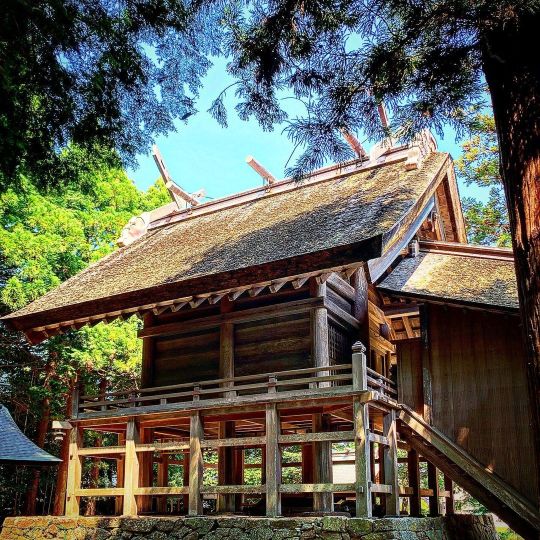
出雲国総社 六所神社 旧暦神有月には全国の神々がまず当社に集い、その後佐太神社に遷られるとも伝わります 出雲国府の跡地に鎮座し佐久佐神社に比定される式内社です 古くは出雲国造が神主として奉仕していたと云います 御祭神は伊弉諾尊、伊弉冉尊、天照大神、月夜見尊、素戔嗚尊、大己貴尊で三貴子が祀られる珍しい神社ですが総社らしく各族の統合の象徴という印象を受けました 平安時代に入ると出雲国造祭式の中心は意宇郡から出雲大社へと移っていきますが意宇六社の一社として古代出雲の権威を感じることができるお社様です #六所神社 ⛩┈┈┈┈┈┈┈┈┈┈┈┈┈┈┈┈┈┈┈⛩ 六所神社(ろくしょじんじゃ) 鎮座地:島根県松江市大草町496 主祭神���伊弊諾尊、伊弉冉尊、天照大神、月夜見尊、素盞鳴尊、大己貴尊 社格:式内小社論社 県社 巡拝:出雲國意宇六社 ⛩┈┈┈┈┈┈┈┈┈┈┈┈┈┈┈┈┈┈┈⛩ #意宇六社 #神社 #神社巡り #神社好きな人と繋がりたい #recotrip #御朱印 #御朱印巡り #神社建築#神社仏閣 #パワースポット #松江市 #神有月 #神社巡拝家 (六所神社) https://www.instagram.com/p/Ck9d9lyhBPn/?igshid=NGJjMDIxMWI=
75 notes
·
View notes
Text
Rosaria: Our Lady, Holy Mother
So, I've been replaying Dark Souls 3 and during so, I've honestly been realizing way more about some characters and really indulging in them. One of them is Rosaria, Mother of Rebirth.
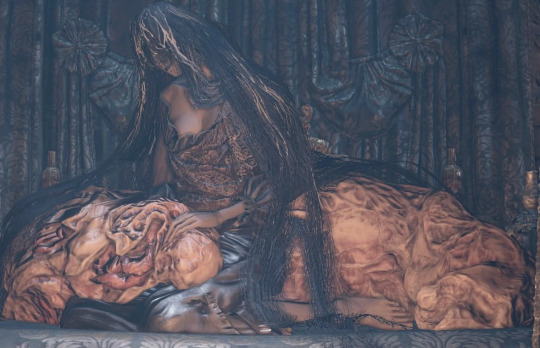
Warning: Spoilers for Dark Souls 3 for the ENTIRE post below!
In Dark Souls 3, there's a particularly interesting character named Rosaria. She leads a covenant called "Rosaria's Fingers" which are directly opposed to the Way of Blue and Blades of the Darkmoon. Which leads us to our first major point; Who is Rosaria and why does she hate the Gods?
At first glance at her character, Rosaria is really dark. As in literally dark, her black clothes, black hair... etc. Opposed to the Gods who are usually represented by White or Divine Colors(See Gwyn's Family) and I'm not sure if it's really intentional but it is something that is obvious. Next, what exactly does Rosaria represent or what is her place in the Dark Souls world? For this, we must look at a Japanese Myth.
The Story of Izanami(伊弉冉尊) and Izanagi(イザナギ) is the basic creation Myth for Japan. They were both the first Man and Woman, they created the first land. They did so with a Spear that was gifted to them and then created the Great Sea. They birthed two children, Hiruko(蛭子) and Awashima(粟島), Hiruko in particular meaning "Leech Child". After giving birth to Kaga-tsuchi(火之迦具土, Literally "Shrine of Flame"), Izanami dies and is sent to the Underworld, becoming the Goddess of Death. Izanagi comes to look for her and while going there, Izanami tells Izanagi not to look at her. However, he does anyways revealing the Underworld has permanently obstructed her form. This terrified Izanagi and he left her in the Underworld. After this, Izanami proclaimed she would kill one thousand people a day but Izanagi said he would father a thousand and five hundred more a day. They were officially divorced in this event.
As we can tell, there are a lot of interesting things we can gather once we connect Izanami to Rosaria. And you might be asking... can we even do that? Well, yes. Rosaria is connected to divinity in some way. Only large people are seen to be deific and once we get Rosaria's Soul(I'll get to that later) we can acquire Gwynevere's Miracles meaning even if she wasn't a god, she was heavily connected to the Gods in such a way she knew and or used these Miracles. It is also worth mentioning that Leonhard calls her a Goddess, but that could be due to his adoration. The other connection is that in some way, Rosaria was betrayed by the Gods so badly she now garners followers in the hopes they will kill members of Royal Covenants and steal something taken from her, tongues. Another connection is Hiruko and the Slug in Rosaria's lap, Hiruko was considered inadequate as a Child and deformed, as you can tell the creature that lays on Rosaria is definitely a deformed creature, similar to the Man Grubs, possibly her Child as it is the biggest(this has no evidence what-so-ever). The last connection is also something pretty interesting; The Deep and the concept of "Kegare(穢れ)".
This leads into a lot, so be wary of this part if you want to read it. So, in Shintoism, water is a very important part of the entire thing. Along with this is the concept of purity through flowing water or "Harae(祓)". Flowing things, especially water, is clear and clean unlike still water which collects grime and impurities. Of course, you want to be clean, right? Well, this is the concept. Flow is good, stagnation is bad. While we are stagnant, whether spiritually or physically, we collect impurities and do not really do anything. You may ask... How does this relate to Rosaria, specifically the connection of her and Izanami? Well, let's look at the place she's at. I don't even mean her room but the entire location. The Cathedral of the Deep is full of Kegare, absolutely full of it. All of the water is disgusting and muddy and mucky, poison comes out of the faucets and the foundation of the Cathedral is sinking. The entirety of the Deep is also just Kegare, but I plan on making a post just on that. So, yes, Rosaria is surrounded by Kegare and so was Izanami. The Underworld filled her with impurities and deformed her entire body. Rosaria seems to be very dirty herself, in her hair is slime and she lacks a tongue, which was stolen from her. Both Women are considered deformed and dirty and are surrounded by stagnation. Rosaria herself does not move and only sits in her Chamber, same with Izanami only staying in the Underworld, stagnating, in a way. Now, this is not extremely high evidence but it is an interesting connection that could explain Rosaria's role and some of her inspiration.
Next is another connection but this time it's in the Universe. This one is quite obvious if you've played Dark Souls 1 and this is Rosaria and Anastacia. Both scenarios play out very similarly. Their Souls are stolen by Men who bring their Souls to Anor Londo but for different reasons. Lautrec's is actually never stated and thusly is unrelated. But Leonhard's is because he wishes for no one else to have her. Claiming that you and most likely everyone else will just steal it too. Why they have similar plotlines, I have no idea and it doesn't really make sense. Though, it is possible that Rosaria is a Firekeeper of some sort as she can Respec(reset skill points) the Player Character and the only other Character's in the series who can do that are Firekeepers. However, her Soul doesn't look like a Firekeeper's(reference below)
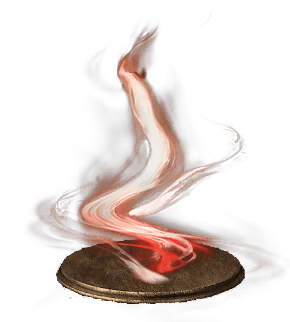
(Rosariaiis's Soul)

(Fire Keeper Soul)
Admittedly, it does look like a bit of Humanity is swirling in her Soul, compared to others but, who knows. She probably is a Firekeeper but we'll probably never get an answer on that. And by the end, Anastasia does have her tongue back but for some reason Rosaria does not and it is absolutely not clear why this is the case.
Next, let's talk about the bit of lore she does have. It's said that her tongue was stolen from her First Born and that could be a lot of people. First off, it does imply more Children and that does fit with something later. So, who is this first Child? Well, most signs point to Aldrich, whose Bodily slime is actually near the doors of Rosaria's Chamber, this proves not a lot but given the fact Aldrich is a cannibal, he definitely did something to her whether or not it be he stole her tongue. But of course, why wouldn't he eat all of her? It's kind of confusing and this part of the lore is extremely lackluster and even if you think about it you can't get anywhere.
Next, let's talk about her Covenant, but before we do that let's ask another question. Is Rosaria someone we have seen before? Well, if you're telling yourself "Hm, she sounds like she could definitely be Gwynevere" you'd be right. Not that she is Gwynevere confirmed but more signs point to yes than no... Let's go over the evidence:
Is a Goddess
Connections to Miracles about Gwynevere
Connections to the Old Gods in some form
Has Children(Amazing point, I know)
Have Magical Abilities
GNow, I know this isn't much but all together it is pretty telling evidence that something is afoot with the connections. Your first thought of it being against is "Oh, well yes it's possible but isn't Gwynevere like 40 feet tall" and well, no, not really. Even in DS1 this can be debunked in the same room(sorta). We all know Gwynevere is an illusion, so how do we know her real size? Well, in the Ornstein and Smough Boss Room we see these statues .
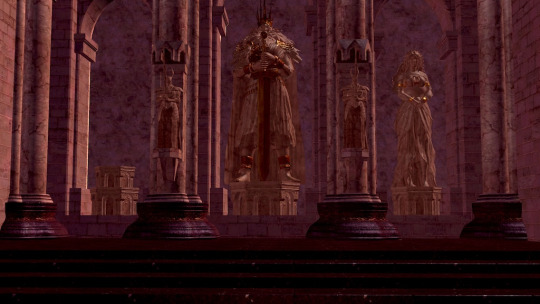
As we can see, Gwynevere is almost as tall as the Gwyn statue which is basically built to scale. Presumably, anyways. And as we can see, Gwynevere is not as big but she is pretty tall. Now, let's compare it to Rosaria(with Player scale too):
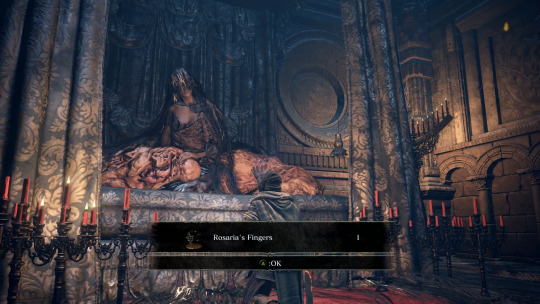
(Source)
As we can see, this height is actually plausible. Rosaria isn't actually that much taller or bigger. Her legs are long and torso about the same size. The next point against it though is the names... Rosaria is obviously not the same as Gwynevere. But, assuming that if you're running away from your family, you'd change your name too. And the Miracle she gives with her Soul, Bountiful Sunlight, which mentions Gwynevere's occupation as a Mother and Wife. This obviously fits in with Rosaria's mentioned child and children, assumedly. But, it's never said that she was married. But, Gwynevere is married, to the God, Flann. They could be hinting at the fact that either Rosaria is Gwynevere's daughter or her, herself.
Another suspect of who she could be is the Queen of Lothric. We know the Queen left after her Husband became mad with the power of the Dragon. There is also evidence for this. Gertrude, the Heavenly Daughter, is said to be the Daughter of the Queen, Rosaria is surrounded by Man-Grubs that are reborn via her and there is actually a Man-Grub near Gertrude's cage. The Queen is said to have several Heavenly Children and the Queen is also compared to a Goddess of Fertility and Bounty(Gwynevere). Rosaria is considered a Goddess and the Queen was worshipped as a Goddess for sure. Another Child of the Queen is the Dancer of the Boreal Valley, how do we know this? Well, the Dancer's Soul gives another of Gwynevere's Miracles, Soothing Sunlight which explicitly states the Dancer is a member of the Old Royal Family, at least for the most part as in it's in her tree. So, how does this connect back the the Queen and Rosaria? Well, it's very much told this way with Miracles the Queen is the Daughter of Gwynevere, who was also her Maiden and carried on the stories of her Mother to her Children. This does make the most sense in comparison to her actually being Gwynevere, but, options. Rosaria's tongue though is still a mystery, I have no idea if her firstborn(presumably Lorian or Aldrich but... that has no evidence) stole her tongue and if that's the case, why. It could just be apart of the hellscape that is Dark Souls 3's lore.
So let's talk about the covenant, Rosaria's Fingers. As to why they are called as such, I am actually not sure and it honestly seems to hold no important to what I see. The member's of this Covenant have a prefix regarding names of specific finger's, somewhat. Yellowfinger is not really a finger. There's also the symbol for the covenant which is actually the Papal Cross of the Christian Religion and is the Emblem of the Pope, there is actually a Pope in Dark Souls 3 in the form of Sulyvahn but there seems to be no connection other than Aldrich being connected to Sulyvahn and that's really it. Rosaria's Fingers collect the tongues of their foes, which are the Way of Blue and Blades of the Darkmoon, two covenants that are explicitly connected to the Old Gods. Obviously, this tells us that Rosaria not only hates the Old Gods but it's possibly they are the ones that stole her tongue from her. Meaning her firstborn is most likely connected to the Old Gods, but as given before, that was obvious. It is either that or the Old Gods have disrupted her in some other way. In other aspects of the Covenant, Rosaria gives the option of Rebirth(or Respec'ing) which basically lets someone reallocate their skills, what implications this has in the universe is completely unknown and is probably just a way to make yourself stronger. You can rebirth yourself in-universe until you become a Man-Grub, and it's basically literally what the name implies. But the descriptions imply it might not be that simple. Some of them wield staffs that cast holy spear spells to protect Rosaria. Why she can do this is not clear, nor why it happens is not clear either. It doesn't seem that she hates her subjects or anything of the sort, so it could just be a curse she has given her abilities.
Rosaria doesn't really have a lot to her character, along with that she barely has lore, unfortunately and all that can be gathered aside from the only clearly stated things is guesswork and it's not that much fun. The only cut things that have come from her is a cut Boss Track related to her(interesting to note this track IS similar to the Dancer's who is interestingly not a Boss at first), whether she was the boss or not, is not clear.
Unfortunately, this seems to be all that Rosaria has to her but if you know anything else or want to correct some information for me please do so! I'll gladly edit something things and I might add more. My next post is hopefully going to be the Angelic Faith of Lothric and the Primordial Serpents.
#Dark Souls 3#Dark Souls III#DS3#Dark Souls Lore#Dark Souls Theory#Soulsborne Lore#Soulsborne#rosaria mother of rebirth
64 notes
·
View notes
Photo
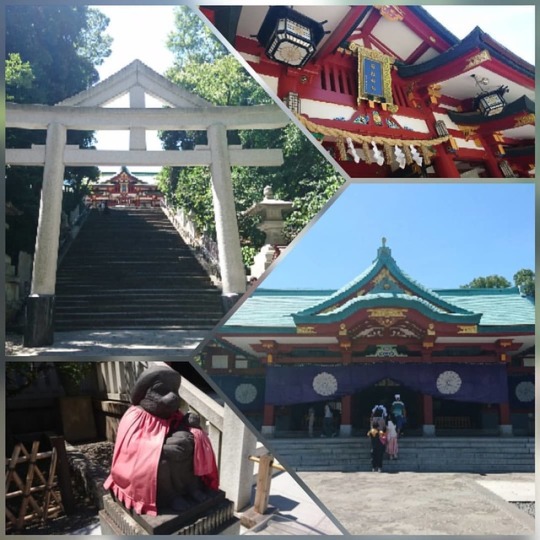
#子宝祈願 を!(^^)/ #日枝神社 #皇城の鎮 #東京十社 #大山咋神 #国常立神 #伊弉冉神 #足仲彦尊 #御朱印巡り #神社 #子授け祈願 #東京都 #永田町 (山王日枝神社) https://www.instagram.com/p/B1C7NVCDLcE/?igshid=ro7asjkhgz4a
0 notes
Text
Japanese divinities ✨
Shinto✨
Major kami✨
•Ama-no-Uzume (天宇受売命)
Commonly called Uzume, she is the goddess of dawn and revelry, instrumental to the "missing sun legend" in Shinto. She is also known as The Great Persuader and The Heavenly Alarming Female.
•Amaterasu-ō-mi-kami (天照大神 or 天照大御神)
Commonly called Amaterasu, she is the goddess of the sun as well as the purported ancestress of the Imperial Household of Japan. Her full name means "Great Goddess" or "Great Spirit Who Shines in the Heavens"; she may also be referred to as Ōhiru-menomuchi-no-kami (大日孁貴神). Due to her ties to the Imperial family, she is often considered (though not official) to be the "primary god" of Shinto.
•Ame-no-Koyane (天児屋命 or 天児屋根命)
A male deity, he is considered the "First in Charge of Divine Affairs", as well as the aide to the first Emperor of Japan.[1] He is also considered to be the ancestor of the Fujiwara family.
•Fujin (風神)
Also known as Kaminokaze, he is the Japanese god of the wind and one of the eldest Shinto gods, said to be present at the creation of the world. He is often depicted as an oni with a bag slung over his back.
•Hachiman (八幡神)
Also known as Hachiman-shin or Yawata no kami, he is seen as the god of war. Originally an agricultural deity, he later became the guardian of the Minamoto clan.
•Inari (稲荷)
The god of rice and fertility. His messengers and symbolic animal are foxes. He is often identified with the Buddhist deity Dakiniten. Though traditionally represented as a male, there are records of Inari appearing as a female as well.
•Izanagi (伊弊諾 or 伊邪那岐)
The forefather of the gods, he is the first male as well as the god of creation and life. He and his wife, Izanami, were responsible for the birth of the islands of Japan and many kami, though she died in childbirth. Later, after his failed attempt to retrieve her from the underworld, he sired Amaterasu, Susano and Tsukuyomi.
Izanami (伊弉冉 or 伊邪那美)
•Izanagi's wife and sister, she is the first female as well as the goddess of creation and death. She died shortly after the birth of Kagu-tsuchi, and Izanami followed her to the underworld, but failed to bring her back to the living world. A marital spat between the pair caused the cycle of life and death for all living beings.
•Ninigi-no-Mikoto (瓊瓊杵尊)
Commonly called Ninigi, he was the grandson of Amaterasu. His great-grandson was Kamuyamato Iwarebiko, later to be known as Emperor Jimmu, first emperor of Japan.
•Raijin (雷神)
Commonly called Raiden (雷電), he is the god of thunder and lightning, and is often paired with Fujin. As with the latter, Raijin is usually depicted as an oni.
•Ryūjin (龍神)
Also known as Rinjin, he is a dragon, as well as god of the sea. He resides in Ryūgū-jō, his palace under the sea built out of red and white coral, from where he controlled the tides with magical tide jewels. His great-grandson would become Emperor Jimmu.
•Susanoo-no-mikoto (須佐之男命)
Alternately romanized as Susano-o, Susa-no-o, and Susanowo. He is the god of storms as well as in some cases the god of the sea. He is also somewhat of a trickster god, as Japanese mythology extensively documents the "sibling rivalry" between him and Amaterasu. Susanoo also was responsible for the slaying of the monster Yamata-no-Orochi and the subsequent discovery of the sacred sword Kusanagi.
•Tenjin (天神)
The god of scholarship, he is the deified Sugawara no Michizane (845-903), who was elevated to his position after dying in exile and subsequent disasters in Heian-kyō were attributed to his angered spirit. See Dazaifu, Fukuoka
•Toyotama-hime (豊玉姫)
Also known as Otohime (乙姫), she was the daughter of Ryūjin and the grandmother of Jimmu. It is said that after she gave birth to her son, she turned into a dragon and disappeared.
•Tsukuyomi-no-Mikoto (月読の命 or 月夜見の尊)
Also known as Tsukiyomi, Tsuki no kami, Tsukiyomino mikoto, and Tsukiyumi no mikoto, he is the god of the moon. He killed the goddess of food, Uke Mochi, out of disgust and anger in the way she had prepared a meal. This caused Amaterasu to never face him again, causing the sun and moon to be in different parts of the sky.
Minor kami✨
•Amatsu-Mikaboshi (天津甕星), the kami of all evil and stars who existed before Ama-No-Uzume
•Konohanasakuya-hime (木花之開耶姫), the wife of Ninigi and daughter of Ohoyamatsumi, and great-grandmother of Jimmu. She is also known as the goddess of Mount Fuji.
•Ohoyamatsumi (大山積命), an elder brother of Amaterasu, and an important god who rules mountain, sea, and war, as well as the father of Konohanasakuya-hime.
•Sarutahiko Ohkami (猿田毘古神), a kami of the Earth that guided Ninigi to the Japanese islands
•Uke Mochi (保食神), sometimes called Ogetsu-hime-no-kami, a goddess of food. After she had spat a fish, vomited or defecated game and coughed rice, she had been killed by a disgusted Tsukuyomi, or in some other versions, Susanoo.
Buddhism✨
•Amida Nyorai (無量光佛 or 無量壽佛)
Commonly referred to as Amida-butsu (阿弥陀如来), he is the primary Buddha of the Pure Land school of Buddhism. He is also believed to be a Buddha who possesses infinite meritorious qualities; who expounds the dharma in his pure paradise and is likely the most well known and popular of the Five Wisdom Buddhas.
•Daruma (ダルマ)
He is traditionally held in Buddhist mythology to be the founder of Zen Buddhism, as well as the founder of Shaolin. One legend reports that after years of meditation, Bodhidharma lost the usage of his eyes and appendages. The Daruma doll was created in honor of this legend.
The Seven Lucky Gods✨
•Benzaiten (弁才天 or 弁財天)
Also known as Benten, she is the goddess of everything that flows: words (and knowledge, by extension), speech, eloquence, and music. Said to be the third daughter of the dragon-king of Munetsuchi, over the course of years she has gone from being a protective deity of Japan to one who bestows good fortune upon the state and its people.Derived from the equivalent goddess in Hinduism Goddess Saraswati.
•Bishamonten (毘沙門天)
Also called Bishamon or Tamonten, he is the god of fortunate warriors and guards, as well as the punisher of criminals. Said to live halfway down the side of Mount Sumeru, the small pagoda he carries symbolizes the divine treasure house that he both guards and gives away its contents.
•Daikokuten (大黒天)
Often shortened to simply Daikoku, he is variously considered to be the god of wealth (more specifically, the harvest), or of the household (particularly the kitchen). He is recognised by his wide face, smile, and flat black hat. He is often portrayed holding a golden mallet, seated on bales of rice, with mice nearby (which signify plentiful food).
•Ebisu (恵比須, 恵比寿, 夷 or 戎)
The sole member of the gods believed to have originated in Japan, he was originally known as Hiruko (蛭子), the first child of Izanagi and Izanami. Said to born without bones, he eventually overcame his handicaps to become the mirthful and auspicious Ebisu (hence one of his titles, "The Laughing God"). He is often depicted holding a rod and a large red bream or sea bass. Jellyfish are also associated with this god and the fugu restaurants of Japan will often incorporate Yebisu in their motif.
•Fukurokuju (福禄寿)
Often confused with Jurōjin, he is the god of wisdom and longevity and said to be an incarnation of the Southern Polestar. He is accompanied by a crane and a turtle, which are considered to be symbols of longevity, and also sometimes accompanied by a black deer. The sacred book tied to his staff is said to contain the lifespan of every person on Earth.
•Hotei (布袋)
Best known in the Western world as the Laughing Buddha, Hotei is likely the most popular of the gods. His image graces many temples, restaurants, and amulets. Originally based on a Chinese Chan monk, Hotei has become a deity of contentment and abundance.
• Kichijōten (吉祥天)
Also known as Kisshōten or Kudokuten, she is the "eighth" member of the Seven Gods of Fortune, a Taoist deity often combined with the traditional members. She is considered to be the goddess of happiness, fertility, and beauty.
• Jurōjin (寿老人)
Also known as Gama, he represents longevity. He is often seen with a fan and a stave, and accompanied by a black deer.
30 notes
·
View notes
Photo

A 19th-century woodblock print from Kumano Hongū Taisha (熊野本宮大社) in present-day Wakayama Prefecture depicting the two progenitor deities first creating land, with the male Izanagi no Mikoto (伊邪那岐命) churning the sea with the Heavenly Jeweled Spear while the female Izanami no Mikoto (伊邪那美命) directs
From the collection of the Museum of Fine Arts, Boston
#和歌山県#wakayama prefecture#熊野本宮大社#kumano hongu taisha#熊野三山#kumano sanzan#伊邪那美命#伊弉冉尊#izanami#伊邪那岐命#伊邪那岐神#伊弉諾尊#izanagi#creation myth
7 notes
·
View notes
Text
生島足島神社/長野県上田市【信州二宮】上田藩主であった真田家の信仰が篤かった朱塗りの社殿
生島足島神社とは 生島足島神社(いくしまたるしまじんじゃ)は、長野県上田市下之郷(ながのけんうえだししものごう)にある神社だ。 真田家の信仰が篤かったといわれ、信州の二宮とされている。 祭神は生島大神(いくしまのおおかみ)、足島大神(たるしまのおおかみ) 創建の年代については明らかではありませんが、神代の昔、建御名方富命(たけみなかたとみのみこと)が諏訪の地に下降する途すがら、この地にお留まりになり、二柱の大神に奉仕し米粥を煮て献ぜられてたと伝えられ、その故事は今も御籠祭という神事として伝えられています。 生島神は生国魂大神、足島神は足国魂大神とも称され、共に日本全体の国の御霊として奉祀され、太古より国土の守り神と仰がれる極めて古い由緒を持つ大神であります。 当社は歴代の帝の崇敬厚く、平城天皇の大同元年(806年)には神戸(封戸)の寄進があり、醍醐天皇の廷喜の代(901年~922年)に…

View On WordPress
#上田市#下之郷#二宮#伊弉冉尊#信州#八幡社#子安社#歌碑#歌舞伎舞台#池心の宮#玉依比売命#生島大神#生島足島神社#直売所#真田#真田信之#神楽殿#神橋#神池#神社#祭神#秋葉社#荒魂社#誉田別命#諏訪社#足島大神#長野県#駐車場
0 notes
Photo









Continuing my journey from Kurama to Kibune :)
It is hard to describe the feeling forests in Japan give off. It feels a bit like getting swallowed up by nature and nature absorbing your thoughts as you walk down the paths. As if you're a red blood cell carrying oxygen through the veins of a giant’s body :)
Kurama is famous for the exposed root systems of some of the trees that are growing on the mountain. It has a very otherworldly feel to it and even more so to Japanese as the afterworld that is described in the 古事記 (Kojiki :) and 日本書紀 (Nihonshoki or Nihongi :) is called the 根の国 or lair of the roots/Rootcountry. It is a place that is dirty to Japanese in a spiritual sense as it has a strong association with death (this is meant to be about the 根の国 not about Kurama and Kibune ;) In the 古事記 and 日本書紀 the mention of the 根の国 is most notable in the story of 伊弉冉尊 (Izanami :) who gave birth to 火之迦具土 (Hinokagatsuchi :) who burned her during birth, causing her to die of her injuries. Her husband (and brother (It’s complicated)) 伊邪那岐命 (Izanagi :) wanted to see her again and went down to the 根の国 to see his beloved wife again but she refused to show herself due to her being burnt and hence disfigured but despite her pleading he managed to catch a glimpse being shocked to see her like this he ran away while she was chasing him which ended in him blocking the entrance to the 根の国 with a large stone and her cursing him telling him that she would kill 100 humans each day and him vowing to build 1000 birthing houses (meaning having 1000 newborns) each day.
So as you walk down the mountain and towards Kibune you feel a bit like returning to the living :) Especially once you walk by the famous restaurants whose most notable feature are their decks that span the stream of a small river which are very enjoyable during summer and refresh you with delicious food and the wonderful surroundings (^-^)
Upon saying goodbye to Kibune i was charmed by the small cute stone figure someone made on top of a switch box at the station :) I like these small details about Japan :)
I dearly miss being in Japan...
This is actually the second time I wrote this article (^-^;) I lost my connection the first time before posting and lost everything I wrote there...
Anyway I’ve started restoring an old drill press for my workshop and feel like fate hates this machine (^-^;) The German postal service broke it during delivery. I managed to fix most of the damage but the motor is sadly too far gone because the shaft got bent too badly :,( So I ordered a new motor, a drill vice, a drill chuck and a replacement belt. I got the wrong motor (7.5 kW instead of 0,55 kW), the wrong drill vice (100 mm instead of 63 mm), the wrong drill chuck (B16 instead of B10) and the wrong replacement belt (6 mm instead of 8 mm)... This is quite bothersome but I plan on pushing through it and this weekend I was able to rebuild the spindle :)
This month there is a lockdown in Germany meaning that I can't go swimming and that I’m spending most of my time at home and working from home. It gets kind of lonely and I've been wishing to have a cat again but it would be difficult to care for it once I start going to the office again (-_-) I have kind of given up on trying to find a girlfriend now. I’m athletic, intelligent and kind (according to others) yet I seem to be only good enough as a shoulder to cry on and to sort out their troubles but not for more and to be honest I’m tired of it. I’m always helpful and do my best. So hearing someone complain about there not being any good men out there feels insulting and dishonest. Most of the time I get told that I’m too short at 1,74 m (5ft 7″). So to keep my sanity I’ll stay away from dating and concentrate on my friends and family :)
I hope the lockdown will work out and end by the end of November as I miss swimming at the pool a lot... Usually I would go there 3 to 5 times a week and swim for at least an hour so i’m feeling a bit unbalanced due to a lack of exhaustion... (as weird as that may sound).
I wish everyone as great a time as possible during these trying times and sweet dreams (^-^)/
99 notes
·
View notes
Photo










八菅神社(2019/03/20) Hasuge-Shrine
神奈川県愛甲郡愛川町八菅山139 Hasugesan139, Aikogun Aikawamachi, Kanagawa, Japan
祭神は国常立命(くにとこたちのみこと)伊弉諾尊(いざなぎのみこと)伊弉冉尊(いざなみのみこと)誉田別命(ほんだわけのみこと)金山毘古命(かなやまびこのみこと)大己貴命(おおなむちのみこと)天忍穂耳命(おめのおしほみみのみこと)。
創建由緒は『 大宝3年(703年)修験道の開祖役の小角(役の行者)が日本武尊ほか6神を祀り修法を行った。そのとき八丈八手の玉幡が山中に降臨し神座の菅の菰から八本の根が生え出たという。そこで山の名を八菅山とよぶようになった。これが八菅神社のはじまりであると伝えられている。 』【神奈川県神社庁HPより抜粋】
190 notes
·
View notes
Text
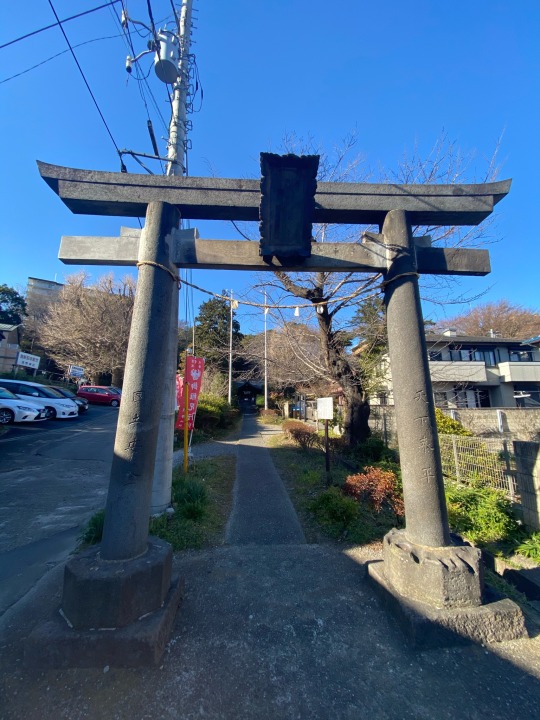

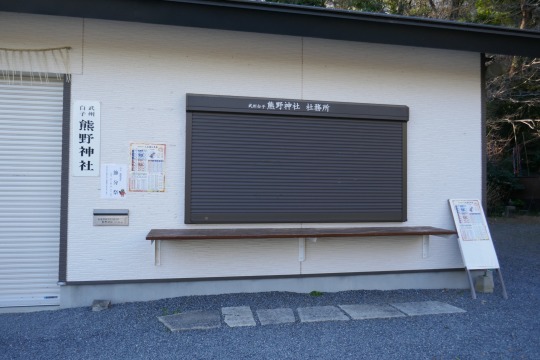
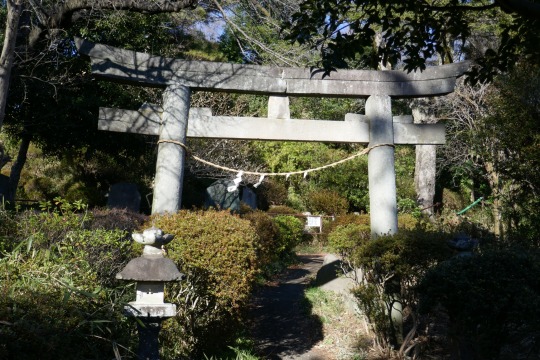


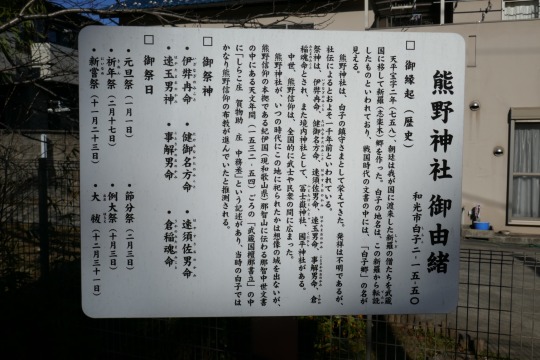
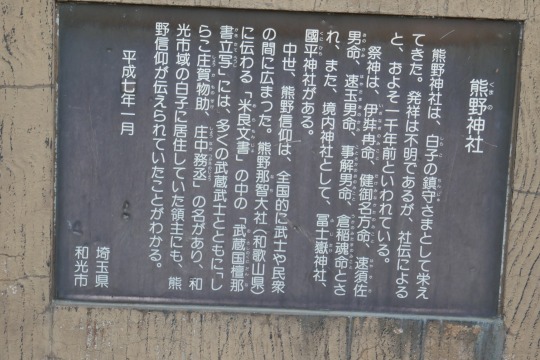

.
2020年2月6日
⛩
武州白子熊野神社 埼玉県和光市白子2-15 祭神は伊弉冉尊、建御名方命、速須佐男命、速玉男命、事解男命、倉稲魂命です。
⛩
他の方の投稿で気になっていた、武州白子熊野神社さんへ行って来ました。('∇')
⛩
最初は自転車で行こうかと思ったんですが、あまりにも風が強かったので、東武東上線で成増へ行き徒歩で向かいました。f^_^;
⛩
成増駅からは徒歩13分位で、旧川越街道沿いにあります。
⛩
境内には登頂可能な藤塚もありましたし、シャッターが閉まっていましたが立派なお社務所もありました。
日を改めてまたお詣りしてみたいと思います。
⛩
#御朱印 #御朱印帳 #埼玉県 #和光市白子 #熊野神社 #武州白子熊野神社
3 notes
·
View notes